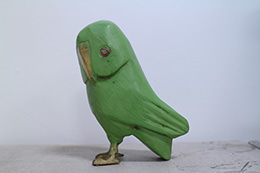[Question 3] What should I do if the picture isn’t as bright as I expected?
When a picture does not appear as bright as it should, remember to use the Exposure Compensation function to resolve such issues. The exposure determined automatically by the camera will not necessarily turn out to be as bright as what you had in mind. In this case, you can adjust to the preferred brightness by darkening or brightening your photos. (Edited by Camera Biyori, Photos by: Yuji Ogura)

A: Adjust to the preferred brightness with Exposure Compensation


Adjust the Exposure Compensation using the “+/-” as well as other buttons. Increase the brightness with “+” compensation and decrease it with “-” compensation.
Camera Settings

P: Program Auto, Av: Aperture-Priority AE, Tv: Shutter Speed-Priority AE
I want to capture human skin beautifully!

No exposure compensation (±0)
A slightly dark impression.

Positive compensation
A bright and refreshing look.
I want to capture awesome nightscape shots!

No exposure compensation (±0)
Slight blowouts occur in the bright areas.

Negative compensation
The colour tone of the street lights is brought out and looks sharper.
I want to use backlight to create an impression of being wrapped in light!

No exposure compensation (±0)
Shot taken with backlight and without exposure compensation. The captured flowers look dull.

Positive compensation
When the exposure compensation is increased, the contours are fringed in light, making the photo appear soft and gentle.
Take Note!
Be careful not to over-compensate as the recording information will disappear. If it is too bright, blowout occurs but if it is too dark, black crush can occur as well.
Have fun changing your photo’s colour tone using White Balance!
What is WB (White Balance)?
The “colour tone” of light changes depending on the time of day and light source (lighting). This is known as the “colour temperature” and is expressed in units of Kelvin (K). A digital camera’s “White Balance (WB)” compensates for a colour’s tendency to appear red or blue depending on the colour of the light. Although it is a function used for making white objects achieve a finishing colour closer to white, it can also be purposely used to add a red or blue tone to your photos.

The White Balance is adjusted with the [WB] button.
Camera Settings

P: Program Auto, Av: Aperture-Priority AE, Tv: Shutter Speed-Priority AE, M: Manual
Different WB Settings

Auto

Auto can be used as the basic setting.
Typical light sources such as [Daylight], [Shade], etc., are pre-set in the camera. Have fun changing the colour tone by setting the WB to one different from the light source at the site.

Daylight


Shade


Cloudy


Tungsten light


White fluorescent light

Light controls the brightness of a photo and is an important element in creating the mood. You can focus on the direction and intensity of the light as well to create photos closer to what you desire.

Ogura's work in photography expands from shooting photographic works to development and printing films. He is one of the tutors at the "Camera Biyori Photography School". He started his career as an engineer at a film laboratory and later establishes his own "mogu camera" lab. He also runs the "mogu sun" portrait studio.

Camera Biyori is a Japanese photography magazine introducing charming photos and daily joy with cameras. Suggesting fun activities relating to cameras and photography, Camera Biyori editorial department also offer the "Camera Biyori Photography School" to recommend its readers to engage in photography and have fun.
Published by Daiichi Progress Inc.

































